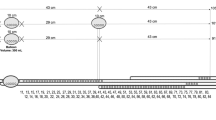Purpose
Manometry and pressure-volume measurements are commonly used to study anorectal physiology. However, the methods are limited by several sources of error. Recently, a new impedance planimetric system has been introduced in a porcine model. It allows simultaneous determination of anorectal pressures and multiple rectal luminal cross-sectional areas. This study was designed to study normal human rectoanal motility by means of impedance planimetry with multiple rectal cross-sectional areas and rectal and anal pressure.
Methods
Twelve healthy volunteers (10 females), aged 24 to 53 years, were studied during one-hour fasting and one hour after a meal. Rectal cross-sectional areas were determined at five levels each 2 cm apart, as well as rectal and anal pressure.
Results
A number of rectoanal motility patterns were observed. A total of 25 episodes with very localized cyclic rectal contractions detected at only one of five channels were observed lasting two to four minutes with a median frequency of three per minute (range, 2-). A total of 44 episodes of cyclic rectal contractions propagating over two or more channels were detected lasting 2 to 36 minutes. Most were associated with contractions of the anal canal. A significant increase in rectal contractile activity was observed after the meal (P-lt;-.05). Single rectal contractions were observed in 11 subjects, and the majority were located to one channel and lasted less than 40 seconds. In two subjects who felt a need to defecate during the experiment, the cross-sectional area at all channels showed strong cyclic contractile activity and the anal pressure increased by approximately 100 percent.
Conclusions
The new rectal impedance planimetry system allows highly detailed description of rectoanal motility patterns. It has promise as a new method for description of rectoanal motility in further studies.
Similar content being viewed by others
References
Gregersen H. Biomechanics of the gastrointestinal tract. New perspectives in motility research and diagnostics, London: Springer-Verlag, 2003:73–131.
Sasaki Y, Hada R, Nakajima H, Munakata A. Difficulty in estimating localized bowel contraction by colonic manometry: a simultaneous recording of intraluminal pressure and luminal calibre. Neurogastroenterol Motil 1996;8:247-3.
Harris JH, Therkelsen EE, Zinner NR. Electrical measurements of urethral flow. In: Urodynamics. London: Academic Press, 1971:465-2.
Gregersen H, Andersen MB. Impedance measuring system for quantification of cross-sectional area in the gastrointestinal tract. Med Biol Eng Comput 1991;29:108-0.
Dall FH, Jørgensen CS, Houe D, Gregersen H, Djurhuus JC. Biomechanical wall properties of the human rectum. A study with impedance planimetry. Gut 1993;36:1581-.
Krogh K, Ryhammer AM, Lundby L, Gregersen H, Laurberg S. Comparison of methods used for measurement of rectal compliance. Dis Colon Rectum 2001;44:199–206.
Krogh K, Mosdal C, Gregersen H, Laurberg S. Rectal wall properties in patients with acute and chronic spinal cord lesions. Dis Colon Rectum 2002;45:641-.
Villadsen GE, Storkholm JH, Hendel L, Vilstrup H, Gregersen H. Impedance planimetric characterisation of esophagus in systemic sclerosis patients with severe involvement of esophagus. Dig Dis Sci 1997;11:2317-6.
Andersen IS, Gregersen H, Buntzen S, Djurhuus JC, Laurberg S. New probe for measurement of dynamic changes in rectum. Neurogastroenterol Motil 2004;16:99–105.
Andersen IS, Rijkhoff NJ, Vukovic A, Buntzen S, Djurhuus JC, Laurberg S. Anorectal motility responses to selective stimulation of the ventral sacral nerve roots in an experimental model. Br J Surg 2005;92:1513-.
Whitehead WE, Delvaux M. Standardization of barostat procedures for testing smooth muscle tone and sensory threshold in the gastrointestinal tract. The working team of Glaxo-Wellcome Research, UK. Dig Dis Sci 1997;42:223-1.
Toma TP, Zighelboim J, Philips SF, Talley NJ. Methods for studying intestinal sensitivity and compliance: in vitro studies of balloons and a barostat. Neurogastroenterol Motil 1996;8:19–28.
Madoff RD, Orrom WJ, Rothenberger DA, Goldberg SM. Rectal compliance: a critical reappraisal. Int J Colorectal Dis 1990;5:37–40.
Narducci F, Bassotti G, Gaburri M, Morelli A. Twenty-four hour manometric recording of colonic motor activity in healthy man. Gut 1987;28:17–25.
Kumar D, Williams NS, Waldron D, Wingate DL. Prolonged manometric recording of anorectal motor activity in ambulant human subjects: evidence of periodic activity. Gut 1989;30:1007-1.
Steadmann CJ, Philips SF, Camilleri M, Haddad AC, Hanson RB. Variation of muscle tone in the human colon. Gastroenterology 1991;101:373-1.
Herbst F, Kamm MA, Morris GP, Britton K, Woloszko J, Nicholls RJ. Gastrointestinal transit and prolonged ambulatory colonic motility in health and faecal incontinence. Gut 1997;41:381-.
Rao SS, Welcher K. Periodic rectal motor activity: the intrinsic colonic gatekeeper? Am J Gastroenterol 1996;91:890-.
Duthie HL, Watts JM. Contribution of the external anal sphincter to the pressure zone in the anal canal. Gut 1965;6:64-.
Shafik A, El-Sibai O, Shafik AA. Physiological basis of digital-rectal stimulation for bowel evacuation in patients with spinal cord injury. Identification of an anorectal excitatory reflex. J Spinal Cord Med 2000; 23:270-.
Shafik A, Shafik AA, Ahmed I. Role of positive anorectal feed-back in rectal evacuation. The concept of a second defecation reflex: the anorectal reflex J Spinal Cord Med 2003;26:380-.
Shafik A, Shafik AA, El-Sibai O, Ahmed I. Study of the role of the second defecation reflex: Anorectal excitatory reflex in the pathogenesis of constipation. J Am Coll Surg 2003;196:729-4.
Gregersen H, Liao D. New perspectives of studying gastrointestinal muscle function. World J Gastroenterol 2006;12:2864-.
Petersen P, Gao C, Arendt-Nielsen L, Gregersen H, Drewes AM. Pain intensity and biomechanical responses during ramp-controlled distension of the human rectum. Dig Dis Sci 2003;48:1310-.
Hancock BD. Measurement of anal pressure and motility. Gut 1976;17:645-1.
Waldron DJ, Kumar D, Hallan RI, Williams NS. Prolonged ambulant assessment of anorectal function in patients with prolapsing hemorrhoids. Dis Colon Rectum 1989;32:968-4.
Sørensen SM, Gregersen H, Sørensen S, Djurhuus JC. Spontaneous anorectal pressure activity: evidence of internal anal sphincter contractions in response to rectal pressure waves. Scand J Gastroenterol 1989;24:115–200.
Acknowledgment
The authors thank Dr. Lars Bolvig from the Department of Radiology, Aarhus University Hospital, who has performed the ultrasonographic examination of the placement of the probe.
Author information
Authors and Affiliations
Corresponding author
About this article
Cite this article
Andersen, I.S., Michelsen, H.B., Krogh, K. et al. Impedance Planimetric Description of Normal Rectoanal Motility in Humans. Dis Colon Rectum 50, 1840–1848 (2007). https://doi.org/10.1007/s10350-007-0307-5
Published:
Issue Date:
DOI: https://doi.org/10.1007/s10350-007-0307-5




